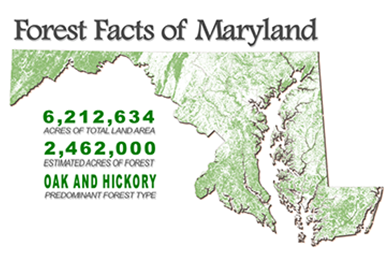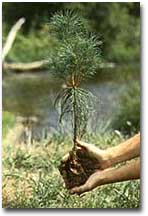
Forests of Maryland 2016, provides an overview of forest resources in Maryland based on inventories conducted by the U.S. Forest Service, Forest Inventory and Analysis (FIA) program of the Northern Research Station.
Quick Facts:
- Landscaping, especially with trees, can increase property values as much as 20%.
- One acre of forest absorbs six tons of carbon dioxide and produces four tons of oxygen. This is enough to meet the annual needs of eighteen people.
USDA Forest Service
- For every 10,000 miles driven in a vehicle that gets 20 mpg plant 15 trees to offset the CO2 production.
- Tree loss has a financial cost. Tree loss in the Baltimore-Washington region since 1973 has resulted in a 19% increase in stormwater runoff (540 million cubic feet) at a cost of $1.08 billion
American Forests
State Tree
Maryland's State Tree is the White Oak. It is the most abundant species of oak growing in Maryland and is found in every county and Baltimore City.
Maryland State Arbor Day is the first Wednesday in April. National Arbor Day is always the last Friday in April.
Tree Species of Maryland
The many different tree species which grow throughout Maryland do so because of a combination of factors: climate, soil, and topography. Because of its location, Maryland is a common meeting ground for several species from both northern and southern climates. The State marks the farthest north that such species as loblolly pine and bald cypress are found. Red spruce is found in Garrett County and is at the southernmost point in its natural range. It is generally recognized that over 160 native or naturalized tree species can be found in Maryland.
Tree Planting
Every year the Maryland Department of Natural Resources Forest Service's Forest Rangers assist communities and individuals in planting thousands of trees in Maryland's urban and rural areas. The service offers many tree planting opportunities through programs such as Forest Stewardship, Urban and Community Forestry, TREE-MENDOUS MARYLAND, Arbor Day and planting school forests in cooperation with local Forestry Boards.
Planting trees improves water quality, resulting in less runoff and erosion. This allows more recharging of the ground water supply. Wooded areas help prevent the transport of sediment and chemicals into streams -
USDA Forest Service.
Forest Watersheds
Maryland's location in the humid east provides it with an abundant supply of water - approximately 20,000 billion gallons annually. Of this total, 14,000 billion gallons are available for use but less than 2 percent, or 303 billion gallons is used annually.
The remaining water either flows downstream to the Chesapeake Bay, the Atlantic Ocean or evaporates into the air. Precipitation is intercepted and infiltrated into the soil by the forests across 42 percent of the State. Forests and their floors of absorbent litter and humus provide an exceptionally efficient water filtering system, and water reaching the groundwater aquifers or appearing in the streams and rivers is of high quality.
Unfiltered surface runoff, however, may transport a variety of pollutants directly into open waters. But -- a forest buffer adjacent to a stream can serve as a natural filter and remove many pollutants.
Forest Resource Protection
Each year more than 6000 natural cover fires occur in Maryland burning an estimated 8,000-10,000 acres of forest and marsh land. The three main causes of forest fire throughout the State are: arson, debris burning, and children playing with fire.
Maryland experiences both spring and fall fire seasons. At these times the climate and fuel conditions are such that the result is a greater chance for an outdoor fire to occur.
Not only are our forest resources threatened by fire but by insects and disease also. Maryland's history tells us of the wonderful American chestnut tree which grew across much of the State. But due to chestnut blight disease which was introduced in the early 1900's, these trees are now very rare. When they do grow they only achieve a small size before succumbing to the blight.
Recently, infestations of the gypsy moth and the Southern pine bark beetle have threatened Maryland's woodlands. Since 1982, more than 400,000 acres of forests have had moderate or heavy gypsy moth deforestations. The extent of damage to the pine resource on the Eastern Shore by the Southern pine bark beetle has fluctuated over the years. Other insect pests affecting Maryland's forests include the loblolly pine sawfly and the fall canker worm. While not causing mortality as extensive as the gypsy moth or the Southern pine bark beetle, infestations of each of these pests in recent years have resulted in considerable loss in growth and productivity of existing trees.
How to Plant Your Tree
 Here you are with a new tree. What should you do with it? Plant it and enjoy watching it grow. It's easy - just follow these directions.
Here you are with a new tree. What should you do with it? Plant it and enjoy watching it grow. It's easy - just follow these directions.
Get your seedling in the ground as soon as you can. Don't let its roots get dry before you plant it.
Decide where you want to plant your tree. Seedlings (baby trees) will grow either outdoors or in a pot on your porch or patio.
Dig a hole deep enough for its roots to fit in without being bent or broken. Hold your tree in the hole and carefully fill the hole with good soil. Then pack the soil firmly around the roots.
After your tree is planted, don't just forget it. It is important to water young trees during the summer months. Take care of it and watch it grow.
Tree seedlings grown at the State's John S. Ayton Tree Nursery are generally planted when they are two years old. After the seed is collected in the fall of the year, it is sown in beds at the nursery. In the spring, the seeds germinate and the tender seedlings are watered and weeded throughout the spring and into the summer.
Forest Industry
The forest industry is the fifth largest industry in the State. It is estimated that more than 18,000 people depend on the forest products industry for their livelihood. In Garrett and Allegany Counties, it is the single largest employer and on the Eastern Shore, it is the second largest. Maryland's forests supply wood for homes, furniture and paper products. Today more acres are producing wood for homes, furniture and paper products. Today more acres are producing wood fiber than 100 years ago.
History of the Forest Service
The Maryland Department of Natural Resources Forest Service has been serving the public and managing the natural resources of Maryland since 1906. The Service was formed after a plot of land known as Garrett State Forest in Garrett County was given to the State by John and Robert Garrett. Since then, public landholdings increased and for many years the combined Forest and Park Service was the caretaker of the state parks and forests and assisted many private landowners with managing their forests throughout the State.
More information about the Forest Service History